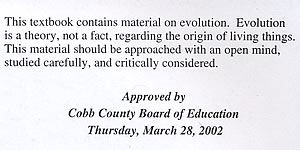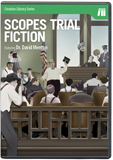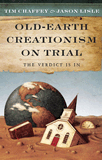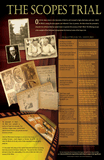
Creation, the Culture Wars, and the Courts
With the passing of the chief justice of the US Supreme Court William Rehnquist, Judge Roberts has been approved by the full Senate and awaits being sworn in as Chief Justice.
The passing of the chief justice of the US Supreme Court, William Rehnquist, and his judicial legacy—and the subsequent, somewhat contentious Senate hearings of his presidentially nominated successor, John Roberts—have provided much fodder for the US news media as it reflects on today’s so-called “culture wars.”
Now that Judge Roberts has been approved by the full Senate and awaits being sworn in as Chief Justice, the focus now shifts to the search by President George Bush for a successor to resigning Justice Sandra Day O’Connor. This promises to see even more media attention and to generate increased partisan Republican/Democratic bickering over an immensely important judicial appointment. (Indeed, many political observers conclude that the Supreme Court is now the most significant part of the triumvirate of the executive, legislative and judicial branches of the US government in the shaping—or re-shaping—of American society, as it makes decisions on abortion, school prayer, etc., which may have been the primary domain of the legislative branch decades ago.)
Perhaps surprisingly, no politician (including the US Senators who spent several days peppering Judge Roberts with questions about his judicial views) we are aware of has brought up the growing controversy over the teaching of origins in public schools in the debate over filling two Court vacancies. Further, to our knowledge, no major media outlet, when summarizing Judge Rehnquist’s judicial record, has noted his dissenting vote in the famous 1987 Supreme Court decision that determined that states could not mandate that creation be taught in the science classes of their public schools. So even though the creation/evolution debate is a major part of America’s culture wars today, it is surprisingly off the radar (at the moment) in the discussion on filling the two Supreme Court vacancies. 1
Read the full dissent by Chief Justice Rehnquist and Justice Scalia to the famous 1987 Supreme Court decision against the teaching of creation in public schools.
It appears (after some research) that Judge Roberts has not commented publicly on the topic of how to teach biological origins in a science classroom. If he had indicated any preference in seeing (or not seeing) that instructors had the academic freedom to teach the creation/evolution debate, then that would have been probably brought up by some opponents to his nomination.
When the successor to Judge O’Connor is nominated by the president (coming soon), that nominee’s hearing before the same Senators will probably become even more heated, as the president’s opponents will try to prevent a shift towards a more conservative court (they want to see at least a “moderate” judge seated on the Court—as O’Connor has been so often described). Any potential nominee’s public views on origins and his/her opinions on any previous court decisions on the teaching of creation or intelligent design may be a part of the intensive background checks being conducted by the president’s advisors.
Chief Justice Rehnquist and Creation vs. Evolution in Schools
As historians now are reflecting on Mr. Rehnquist’s legacy, it has not been noted (to our knowledge) that his dissenting vote in the previously mentioned Edwards v. Aguillard case gave evolution opponents (i.e., literal creationists, as well as those in the Intelligent Design movement) a possible legal strategy to employ to undermine evolution-only teaching.
While the Supreme Court ruled 7–2 against the balanced treatment of origins (i.e., both creation and evolution) in Louisiana’s public school science classes, Justice Antonin Scalia (with Rehnquist agreeing) wrote that evolution critics in Louisiana were “entitled, as a secular matter, to have whatever scientific evidence there may be against evolution presented in their schools.” 2 One of the long-time groups opposing creation and intelligent design in schools, Americans United for Separation of Church and State, even acknowledged how the Rehnquist/Scalia dissent in 1987 helped see a change in strategy for those attempting to challenge the dominance of evolutionary teaching in public schools. 3 More about that in a moment.
Federal Court Decisions in Recent Times on Origins Teaching
Recent attempts to bring more balance in schools about the teaching of origins, however, have not fared well in the federal courts since the 1987 Supreme Court decision. In its ongoing general antagonism toward any hint of biblical Christianity appearing in public life, the Supreme Court decided in 2000, for example, to let stand a lower court ruling that had struck down a policy in a Louisiana school district that mandated that teachers in public schools read a disclaimer about the validity of evolution to their students.
The Court (in a 6–3 vote) declined to review an appeal by the school board of Tangipahoa Parish, which had required that its instructors in kindergarten through grade 12 tell their students that the “scientific theory of evolution … was not intended to influence or dissuade the biblical version of creation.” This 1994 policy had been previously struck down by a federal judge and then a US federal appeals court. The appeals court ruled that the disclaimer about evolution endorsed religion and advanced a particular religious viewpoint, even though there was no mandating that creation be taught. The school board had appealed to the Supreme Court, arguing that students had a right to form their own opinions—or maintain their existing beliefs—regarding the topic of biological origins.
At the time, Ken Ham, president of Answers in Genesis–USA, declared that he “was not surprised by the actions of the federal courts, given their recent hostility to any mention of biblical Christianity in schools.” He continued: “These actions only reinforce our belief that the best strategy to influence schools is one that uses grassroots efforts—not the current court system—to help students hear both sides of the creation/evolution debate.”
Even with AiG’s reservations about the strategy used by the school board in this controversy, AiG disagreed with the federal courts actions (including the Supreme Court’s vote to let stand the lower court ruling), and agreed with the dissenting opinion of Justices Rehnquist, Scalia and Clarence Thomas that other theories of origins are worthy of consideration in public schools. As Justice Scalia observed, only evolution is being taught in the school district in question, and no other theories were being mandated at all, so no religion was being promoted (as reported by the Reuters news service, June 19).
The striking down by federal courts of a modest effort by a school board to de-emphasize the dogmatic teaching of evolution through a disclaimer exposed the humanistic agenda of many of the judges in the federal court system. Rulings like this helped to confirm that America is correctly labeled now as a “post-Christian” nation.
More recently (January 2005), a US District Judge, Clarence Cooper, handed down a ruling in the case of Selman v. Cobb County School District, in which parents challenged a school board decision to place evolution disclaimer stickers in the front cover of some high-school biology textbooks in Cobb County, Georgia.

Photo of controversial Georgia sticker.
The question for this federal court was: did this 33-word disclaimer (right), which cautioned students about evolution, violate the US Constitution by “establishing religion”?
Yes, the stickers are an unconstitutional endorsement of religion, said Judge Cooper in his ruling. Therefore, the stickers had to be removed from the textbooks.
In an Associated Press article (January 13, 2005) that was immediately picked up by dozens of news outlets from South Africa to South Dakota, Judge Cooper explained his decision in the following statement:
By denigrating evolution, the school board appears to be endorsing the well-known prevailing alternative theory, creationism or variations thereof, even though the sticker does not specifically reference any alternative theories [emphasis added].
As a result of this federal court’s bizarre ruling (which included a comment that expressed concern about not wanting to upset those who hold evolutionary beliefs), the sticker had to be removed from Cobb County high school biology textbooks because they supposedly went against the First Amendment, for Judge Cooper concluded that they conveyed a message of endorsement of religion.
Ken Ham commented at the time: “This ruling by Judge Cooper is preposterous. Here you have a sticker that doesn’t mention God, prayer, the Bible, creation … and it’s considered religious because the people behind it believe in God.”
Ham added: “So, even when you leave God out, leave creation out, and just have a sticker that talks about evolution, a judge considers that to be religious because the people that came up with it have a religious belief. Do you see the inconsistency here?”
Some observers thus saw this decision as another example of an “activist judge” who grossly misinterpreted the “establishment-of-religion” clause in the Constitution.
This week, another federal court is hearing a case about the question of origins in schools. In the case of a Dover, Pennsylvania school district, a federal judge is scheduled to make a decision sometime next month about whether the school district can inform its students about intelligent design (although not to teach it—the district wants students to hear a brief statement about evolution and an ID textbook available to read in the school library if a student wanted to). See our article “Defending ‘Design’ in Dover (Pennsylvania, USA).”
The 1987 Supreme Court Decision and Its Impact on Today’s Science Classes
Many in public education and the scientific establishment have been attempting to use the 1987 Supreme Court decision to censor scientific evidence in public schools that refutes evolution and advances any concept of creation. That 1987 decision is being applied incorrectly, although with success by evolution proponents, as we have just shown. But what did that Court really rule?
The 1987 Court noted (in Edwards v. Aguillard) that teachers are “free to teach any and all facets of this subject” of all scientific theories about the origins of humankind (p. 9).
As ICR pointed out in 1987, the ruling actually provided a “green light” for alternatives to be taught, even though its teaching cannot be mandated, and even though it prohibits the teaching of biblical creation.
In their powerful dissent, Chief Justice Rehnquist and Justice Scalia also acknowledged that “evolution is not unquestionable fact” (p. 25). They also chastised the majority for its “Scopes-in-reverse” “repressive” position (p. 25).
Teachers, of course, have always had the right and academic freedom to present the problems with evolution theory and did not need the Louisiana law to give it to them. In fact, ICR indicated at that time that creationists should be thankful that the Court did not go so far as to ban anti-evolution teaching.
Perhaps some future test case will see an improvement over the current Court leanings and not make it any worse for those who want to challenge evolutionary dogmatism. But a history of previous attempts to promote creation by legislation or litigation have not gone well at all. (Note that both ICR and AiG have long maintained that anti-evolution instruction or the presentation of alternate views to evolution can best be promoted through educating the public rather than through the courts or legislation; therefore, neither group will probably get directly involved in either litigation or by pushing particular origins laws.)
School boards and teachers, at the very least, should be strongly encouraged to present scientific evidences and arguments against evolution in their classes even if they don’t wish to recognize these as evidences and arguments for creation.
Conclusion
Perhaps the most important decision(s) a US president will make during his tenure is the appointment of federal judges, with no term limits, to the Supreme Court and other federal courts. Whether it’s the words “under God” in the Pledge of Allegiance being constitutional (soon to be argued before the Supreme Court) or whether it’s something even more dire in society (such as the abortion issue), these are not simply issues between Republicans and Democrats (as what might be falsely concluded given the current partisan battles over Supreme Court vacancies). They are struggles over two worldviews: biblical Christianity vs. secular humanism.
- Read the complete text of the 1987 dissenting opinion of Rehnquist and Scalia in Edwards v. Aguillard.
Footnotes
- Syndicated columnist Richard Cohen of the Washington Post only alluded to the origins issue and the Supreme Court vacancies when he wrote (regarding Judge Roberts): “We would not want a dunce or a mediocrity to decide the sort of matters that come before the court. Unlike, say, the presidency, the Supreme Court is no place for a sluggish thinker who thinks—if that is the word—that in the schools the non-theory of intelligent design ought to be taught along with the theory of evolution.” (What next, alchemy and chemistry?). Cincinnati Enquirer, September 11, 2005, p. E5.
- This quote comes from the dissenting opinion.
- As cited by the The CQ Researcher 15(17):652, July 29, 2005.
Recommended Resources

Answers in Genesis is an apologetics ministry, dedicated to helping Christians defend their faith and proclaim the good news of Jesus Christ.
- Customer Service 800.778.3390
- © 2024 Answers in Genesis




